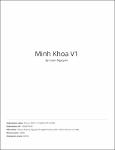| dc.description.abstract | As a computer science student, I focus on the data mining fields of research to take advantage of what I have learn through 4-years education program that leverages mathematical and computational knowledges.
Having a change to work for MWG as a retailer in Vietnam, I find that retail industry as larger space where I can apply academic knowledge to enhance particular business processing. Promotion and Demand Forecasting is the most well-known keywork in retail that requires a lot of mathematical methodologies to solve big problems in term of optimizing business processes as well as firms' resources.
In previous stage of researching (pre-thesis), I have discovered a lot of insight about promotion optimization and how to extend the topics to such a larger scope for multiple items and multiple supermarkets by Cohen et al. (2018). When the optimization model can yield many beneficial insights. The most important missing pieces to implement proposed models is demand forecasting parameter that is the reason I extend the scope of my researching and aim to evaluate demand metrics in retail. Demand metrics in retail show customer's demand toward specific products that depends on certain product's characteristics. When retails can predict accurate demand for specific product, they have to extend their results to matching those measurements to other products which share a certain feature with the indexed product because of a huge variety of products and stock-keeping units. These perspectives give two searching keys which are "Demand Prediction" and "Data Aggregation". From that, I re-propose core algorithm called Data Aggregation and Clustering (DAC). Through theories and mathematical conduction, I have implemented the DAC models and proved its computational efficiently to segment an item to aggregation- level or cluster-level under different features in compare with common and well-known methods. | en_US |


